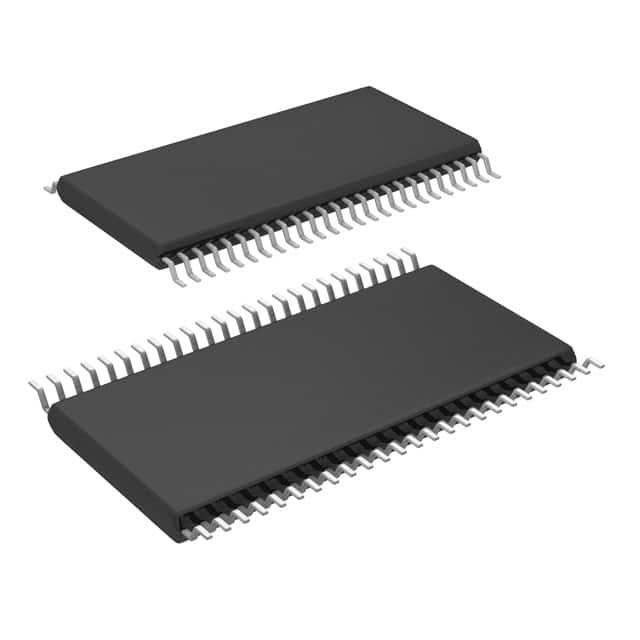Encyclopedia Entry: 74ALVCH16245DGGRG4
Product Overview
Category
The 74ALVCH16245DGGRG4 belongs to the category of integrated circuits (ICs) and specifically falls under the family of bus transceivers.
Use
This product is primarily used for bidirectional data transfer between two buses with different voltage levels. It acts as a buffer, allowing seamless communication between these buses.
Characteristics
- Bidirectional data flow
- Supports voltage level translation
- High-speed operation
- Low power consumption
- Robust design for reliable performance
Package
The 74ALVCH16245DGGRG4 is available in a surface mount package. The specific package type is DGGRG4.
Essence
The essence of this product lies in its ability to facilitate efficient and reliable data transfer between buses operating at different voltage levels.
Packaging/Quantity
The 74ALVCH16245DGGRG4 is typically packaged in reels or tubes, depending on the manufacturer. The quantity per package varies but is commonly around 250 units.
Specifications
- Supply Voltage Range: 1.65V to 3.6V
- Input Voltage Range: 0V to VCC
- Output Voltage Range: 0V to VCC
- Operating Temperature Range: -40°C to +85°C
- Maximum Data Rate: 400Mbps
Detailed Pin Configuration
The 74ALVCH16245DGGRG4 has a total of 48 pins, arranged as follows:
A1 ─────────────── B1
A2 ─────────────── B2
OE ─────────────── GND
DIR ─────────────── VCC
A3 ─────────────── B3
A4 ─────────────── B4
... ... ...
Functional Features
- Bidirectional data transfer: The 74ALVCH16245DGGRG4 allows data to flow in both directions, enabling communication between two buses.
- Voltage level translation: It supports the translation of voltage levels between the input and output sides, ensuring compatibility between different bus systems.
- High-speed operation: This IC is designed to operate at high speeds, making it suitable for applications requiring fast data transfer.
- Low power consumption: The product is optimized for low power consumption, reducing energy requirements and extending battery life.
- Robust design: The 74ALVCH16245DGGRG4 is built with robust components, ensuring reliable performance even in demanding environments.
Advantages and Disadvantages
Advantages
- Enables seamless communication between buses with different voltage levels
- Supports high-speed data transfer
- Low power consumption enhances energy efficiency
- Robust design ensures reliability
Disadvantages
- May require additional circuitry for complex applications
- Limited to specific voltage ranges
Working Principles
The 74ALVCH16245DGGRG4 operates based on a bidirectional transceiver architecture. It utilizes internal circuitry to enable data transfer between two buses with different voltage levels. The direction of data flow is controlled by the DIR pin, while the OE pin enables or disables the output buffers.
Detailed Application Field Plans
The 74ALVCH16245DGGRG4 finds application in various fields, including:
- Computer systems: Facilitating communication between different voltage domains within a computer system.
- Industrial automation: Enabling data exchange between control systems operating at different voltage levels.
- Automotive electronics: Supporting bidirectional data transfer between vehicle subsystems with varying voltage requirements.
- Consumer electronics: Integrating into devices that require voltage level translation for efficient data communication.
Detailed and Complete Alternative Models
- 74ALVC16245: Similar to the 74ALVCH16245DGGRG4, but operates at a lower voltage range of 1.2V to 3.6V.
- SN74LVC16245A: Offers similar functionality with a wider supply voltage range of 1.65V to 5.5V.
- MC74LVX245: Provides voltage level translation capabilities with a supply voltage range of 2.0V to 3.6V.
These alternative models offer comparable features and can be considered based on specific application requirements.
Word count: 511 words
Lista 10 Vanliga frågor och svar relaterade till tillämpningen av 74ALVCH16245DGGRG4 i tekniska lösningar
Sure! Here are 10 common questions and answers related to the application of 74ALVCH16245DGGRG4 in technical solutions:
Q: What is the function of the 74ALVCH16245DGGRG4? A: The 74ALVCH16245DGGRG4 is a 16-bit bus transceiver with 3-state outputs, designed for low-voltage (1.65V to 3.6V) applications.
Q: What is the maximum operating frequency of the 74ALVCH16245DGGRG4? A: The maximum operating frequency of the 74ALVCH16245DGGRG4 is typically around 400 MHz.
Q: Can the 74ALVCH16245DGGRG4 be used for bidirectional data transfer? A: Yes, the 74ALVCH16245DGGRG4 supports bidirectional data transfer, making it suitable for applications where data needs to be transmitted in both directions.
Q: What is the output voltage level of the 74ALVCH16245DGGRG4? A: The 74ALVCH16245DGGRG4 has a low-level output voltage (VOL) of 0.8V and a high-level output voltage (VOH) of 2.4V when operated at a supply voltage of 3.3V.
Q: Can the 74ALVCH16245DGGRG4 handle level shifting between different voltage domains? A: Yes, the 74ALVCH16245DGGRG4 can be used for level shifting between different voltage domains, as long as the voltage levels are within its specified operating range.
Q: Does the 74ALVCH16245DGGRG4 have built-in ESD protection? A: Yes, the 74ALVCH16245DGGRG4 is designed with built-in ESD protection to safeguard against electrostatic discharge events.
Q: What is the power supply voltage range for the 74ALVCH16245DGGRG4? A: The 74ALVCH16245DGGRG4 operates within a power supply voltage range of 1.65V to 3.6V.
Q: Can the 74ALVCH16245DGGRG4 be used in high-speed data transmission applications? A: Yes, the 74ALVCH16245DGGRG4 is suitable for high-speed data transmission applications due to its low propagation delay and fast switching characteristics.
Q: Does the 74ALVCH16245DGGRG4 support hot-plugging of devices? A: Yes, the 74ALVCH16245DGGRG4 supports hot-plugging, allowing devices to be connected or disconnected while the system is powered on.
Q: Are there any specific layout considerations for using the 74ALVCH16245DGGRG4? A: Yes, it is recommended to follow the manufacturer's guidelines for proper PCB layout, including minimizing trace lengths, providing adequate decoupling capacitors, and ensuring signal integrity.


